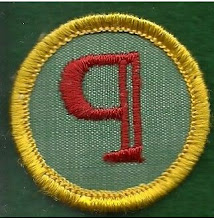 That's the Cadette (Girl Scout) Reporter badge that I earned 'way back when. I’ve wanted to be a writer from my earliest memory; and being a writer
meant being a reporter – a journalist. I did and still do love the clatter of typewriters and the AP
teletype, the smell and sound of the presses; ink on paper. Reporters can crank out stories fast and to length using the inverted pyramid: use the formula, plug in the info and go. Deadline: you've got ten minutes to write 250 words. Go.
That's the Cadette (Girl Scout) Reporter badge that I earned 'way back when. I’ve wanted to be a writer from my earliest memory; and being a writer
meant being a reporter – a journalist. I did and still do love the clatter of typewriters and the AP
teletype, the smell and sound of the presses; ink on paper. Reporters can crank out stories fast and to length using the inverted pyramid: use the formula, plug in the info and go. Deadline: you've got ten minutes to write 250 words. Go.
The first writing
formula I learned was the inverted
pyramid used in news reporting. Who what, when, why, where and how in the first
paragraph. Successive paragraphs reiterate what’s in the first paragraph. It’s
all about what will fit; we cut stories from the bottom and if only one
paragraph fits, the whole story is there.
The Canal Street Warehouses were destroyed by a four-alarm
fire early Tuesday morning. There were no injuries. Fire Marshall Joe Jones
reported that the fire started in the fry house of Pete’s Potato Chips and that
the cause of the fire is under investigation. Pete “Spud” Peterson, owner of
Peterson Foods, was unavailable for comment.
I don’t get to write that Spud Peterson is a roaring
drunk; or he only hired illegals; or his kids are in juvie, or his wife… you get the idea. That’s for the
op-ed pages, letters to the editor or comments on the web page.
Writing
a novel is vastly different. You don’t need to know nuclear astrophysics
(just write a NASA astrophysicist into the story), the horses can talk, and
people can be purple. You can write anything you want! Whee!
But will I want to read it? You have a better chance of finding readers for your work if you organize your creative writing -- thus, the formula. To be clear, in this blog entry I am looking at formulas that help writers generate a lively arc of action. Many of the manuscripts I read have fabulous characters and a muddled arc of action. I seldom see the opposite -- a great arc of action and boring characters. (More on characters next week.)
FORMULA ONE
What happens when in an arc of action can be broken down in several ways. One way to do this is in Story Engineering by Larry Brooks and is briefly summarized below.
- How does the story open? Is there an immediate hook?
- First plot point: the reader is about a quarter of the way into the story and now the hero’s -journey, his agenda – changes. What happens to bring about that change?
- Midpoint twist. Brooks calls this “parting the curtain” – for the character, or maybe only for the reader. What do we know now that changes everything?
- Second plot point: the reader is about three-quarters of the way through the story. The hero should be driving the action—the reader should feel the ending coming up.
FORMULA TWO
I
was a scriptwriter (and script editor) before I tackled writing novels, and I still use my old “beat sheet” to hammer out an arc of action. The beat sheet broke down what happens in every
minute of a two-hour feature film. All the rising and falling action, all the journeys the
characters take, and every revelation can be scripted to the minute. You probably know the beats. For instance, if you are a fan of House, you knew exactly when Hugh Laurie would have the revelation that solved that week's medical mystery.
A great published version of the script beat sheet is Something Startling Happens
by Todd Klick. It’s a great read and you can use it to write novels – instead of
each script page representing a minute of finished film; say that each minute
is one or two or three pages of your manuscript – and there you are, a detailed
outline of arc of action.
Yep, these two formulas are the same thing, stated in different ways; remember that math analogy from last week? Remember: the formula is
not there to constrict you; it’s there so help you organize your information into
a brilliant novel. That’s the deal between the reader and the writer; the writer will give the reader what they expect, but the action will speed up or slow down, the lovers don't quite meet, the dog stays lost... for now.
The writer plays around with the formula.

No comments:
Post a Comment